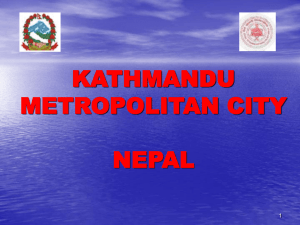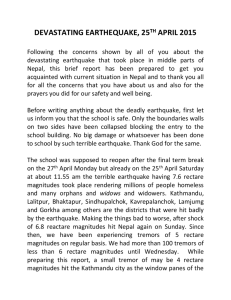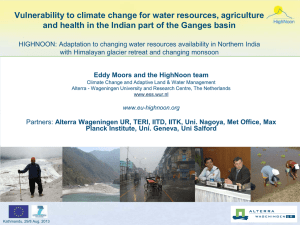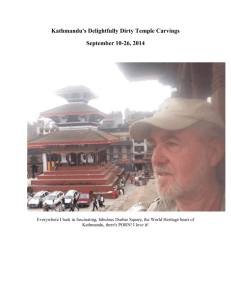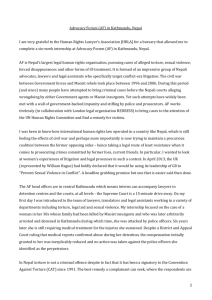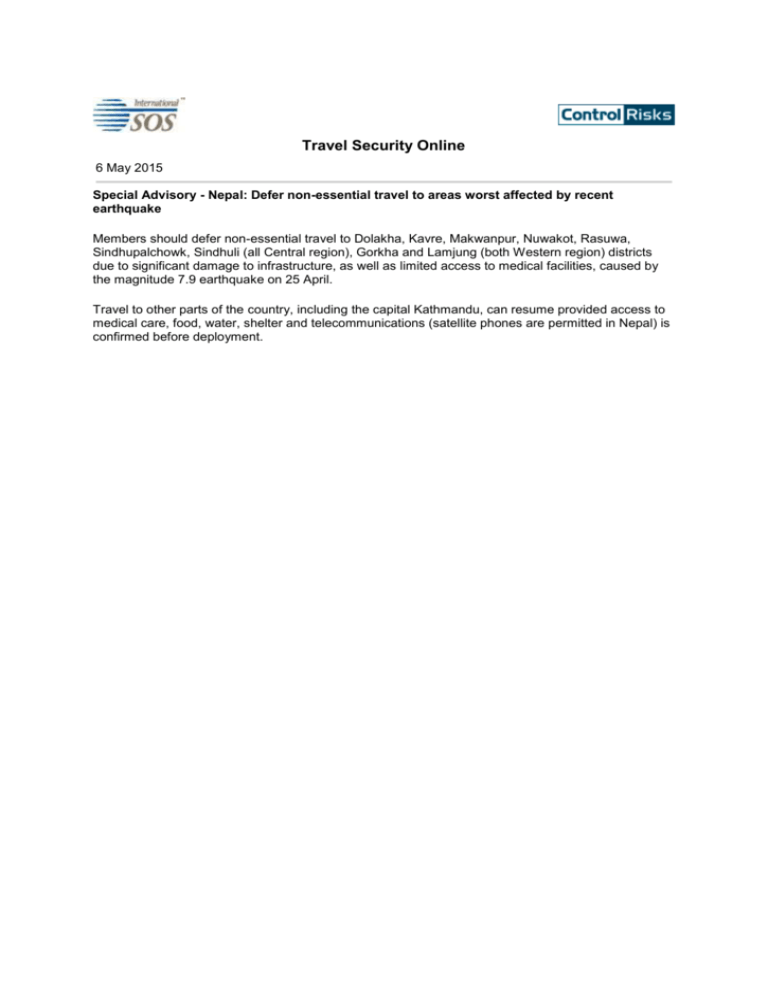
Travel Security Online
6 May 2015
Special Advisory - Nepal: Defer non-essential travel to areas worst affected by recent
earthquake
Members should defer non-essential travel to Dolakha, Kavre, Makwanpur, Nuwakot, Rasuwa,
Sindhupalchowk, Sindhuli (all Central region), Gorkha and Lamjung (both Western region) districts
due to significant damage to infrastructure, as well as limited access to medical facilities, caused by
the magnitude 7.9 earthquake on 25 April.
Travel to other parts of the country, including the capital Kathmandu, can resume provided access to
medical care, food, water, shelter and telecommunications (satellite phones are permitted in Nepal) is
confirmed before deployment.
Travel Briefing
While the extent of the damage is significant, the situation has notably improved in major urban
centres such as Kathmandu and Pokhara (Kaski district, Western region), as well as in areas that only
suffered moderate damage (Far Western region, Mid-Western region and Eastern region). However,
reconstruction will take significantly longer in the worst-affected districts.
Our team of security, medical and logistics experts is currently in Kathmandu, where they are
assisting members and further corroborating information. Details of known disruption are listed below.
Kathmandu valley
Significant damage has occurred in several tourist areas of Kathmandu, including Balaju, Bhaktapur
(immediately outside Kathmandu, Central region), Hanuman Dhoka, Durbar Square area, Sitapaila
Chowk , Sundhara and Teku. However, the city's Thamel area, which is also popular with foreign
travellers, as well as Bhatbhateni, Baluwatar, Lazimpat and Panipokhari have sustained limited
damage.
Kathmandu valley: Transport disruption
Commercial flights at Kathmandu's Tribhuvan International Airport (KTM) continue to operate; delays
are beginning to ease and an increasing number of airlines are resuming services to the facility. The
large crowds of foreigners and locals that had camped at the airport have now begun to subside.
Buses and taxis are operating within Kathmandu, and movement in the city along main thoroughfares
is possible. Travel to the airport should be undertaken only after the status of routes is established
and airline reservations are confirmed.
Travel from Kathmandu north to the Chinese border, including via the Araniko Highway, is restricted
and a number of roads along the border are impassable. The Prithvi Highway between Kathmandu
and Pokhara is also open. The Tribhuvan Highway connecting the capital with Birgunj (Parsa district,
Central region), which serves as a primary border crossing with India, is open.
Air travel is recommended. However, travel along the Tribhuvan Highway to Birgunj, as well as along
the Prithvi Highway to Pokhara, can continue with a trusted driver or government-sanctioned
transport. Do not travel unless you have confirmed that planned routes are clear, and have the ability
to respond to further incidents, such as further aftershocks, landslides and blocked roads. All
movement should be in daylight hours only. Any movement should be undertaken after obtaining
profile- and itinerary-specific advice from your nearest Assistance Centre.
Kathmandu valley: Disruption to essential supplies
Mobile telecommunications networks in the valley are largely functional, though communication
remains patchy. Similarly, internet services are only partially functional. Currently, the best way to
communicate with personnel in the country is via SMS services. Power supplies have been largely
restored.
The shortage of food and water supplies in the city has eased. An increasing number of shops
stocked with food, water and basic medicines are open. Petrol stations are open and long lines have
eased. Banks have also reopened and some ATMs are functional.
While several hospitals in the city are operational and the authorities have established 16 emergency
shelters, access to these facilities is entirely dependent upon evacuations by overwhelmed
emergency services and local logistics providers. Furthermore, hospitals and shelters are currently
crowded and hospital supplies are overstretched.
Damage to several hotels has put a strain on the availability of accommodation.
Kathmandu valley: Security concerns
There have been no new reports of looting or unrest since 29 April, when isolated incidents of lootings
of subsistence materials and abandoned homes were reported, particularly in Lalitpur district (Central
region) immediately outside Kathmandu.
On 29 April, frustration over the distribution of aid and the limited ability of residents to travel outside
Kathmandu resulted in scuffles between approximately 200 individuals and the security forces at the
parliament building in the New Baneshwor area of the city, near the airport, as well as in several other
locations in the city. Discontent has been directed towards the authorities, and there have been no
incidents of unrest directed at foreigners.
While these incidents have been isolated and swiftly contained by the security forces, the current
stability of the security environment will depend on the ability of the authorities to deliver additional
relief. The scale of the disaster and the fact that the government and aid agencies are currently
overstretched mean that localised, probably minor, outbreaks of disorder are likely in the short term.
However, we assess that widespread unrest is unlikely.
Pokhara
Early indications are that structures in the city have fared better than those in Kathmandu, and hotels
in the city are able to accommodate guests.
Pokhara: Travel disruption
Local sources have confirmed that Pokhara Airport (PKR) is open to commercial flights.
The Prithvi Highway between Kathmandu and Pokhara is now open. The road between Pokhara and
Siddharthanagar (Rupandehi district, Western region), which serves as a border crossing with India,
is open.
Air travel is recommended. However, travel along the Prithvi Highway to Kathmandu, as well as along
the road between Pokhara and Siddharthanagar, can continue with a trusted driver or governmentsanctioned transport. Do not travel unless you have confirmed that planned routes are clear, and
have the ability to respond to further incidents, such as further aftershocks, landslides and blocked
roads. All movement should be in daylight hours only. Any movement should be undertaken after
obtaining profile- and itinerary-specific advice from your nearest Assistance Centre.
Pokhara: Disruption to essential supplies
Telecommunications are functional. SMS services are the best way to communicate with in-country
personnel. Essential supplies, such as food and water, are available. Banks have reopened and
ATMs are working. Similarly, petrol stations have reopened.
Pokhara: Security concerns
There are currently no indications of incidents of crime, such as the looting of subsistence materials.
The Terai region
The southern Terai region, which lies along the border with India, has suffered significantly less
damage. The Mahendra Highway (also known as the East-West Highway) is open. Air travel is
recommended. However, travel on roads in the area can continue with a trusted driver or governmentsanctioned transport. Do not travel unless you have confirmed that planned routes are clear, and
have the ability to respond to further incidents such as further aftershocks, landslides and blocked
roads. All movement should be in daylight hours only. Any movement should be undertaken after
obtaining profile- and itinerary-specific advice from your nearest Assistance Centre.
Border crossings with India at Birgunj, which lies near Chitwan National Park, as well as at
Siddharthanagar, Nepalganj (Banke district, Mid-Western region), Dhangadi (Siraha district, Far
Western region) and Mahendranagar (Kanchanpur district, Far Western), are open and allowing the
movement of foreigners. India is granting visas-on-arrival to foreigners at the border crossings.
The Indian government has set up relief camps in the districts of Araria, Sitamarhi (both Bihar state,
India), Bahraich, Gorakhpur, Maharajganj, Siddharth Nagar (all Uttar Pradesh state, India), Darjeeling
and Pasupati Phatak (both West Bengal state, India). The camps have medical supplies, food and
water.
Everest area
Tenzing-Hillary Airport (LUA), located in the town of Lukla and serving Namche Bazaar (the starting
point for treks to Everest Base Camp), and the helipad at Namche Bazaar are operating, and
commercial flights are departing; all of the approximately 200 trekkers trapped have been moved from
Everest Base Camp to Lukla and onwards to Kathmandu. Commercial services from Namche Bazaar
to Lukla, as well as from Lukla to Kathmandu, are wholly dependent on weather conditions, which can
change drastically within hours.
Road movement from Lukla is not feasible. Members in Lukla should continue to stand fast until air
options become available. Lukla did not suffer notable damage in the earthquake: food, water,
telecommunications and internet services have not been affected. While the large influx of travellers
to the area has put a strain on accommodation, hotels are nonetheless available.
Other areas
The worst-affected areas include the country's main urban centres in Kathmandu valley, as well as
the districts of Dolakha, Gorkha, Kavre, Lamjung, Nuwakot, Rasuwa, Sindhupalchowk and Sindhuli.
Other areas: Travel disruption
Commercial traffic at other domestic airports has started to resume; due to congestion at
Kathmandu's airport, flights are using other facilities such as Biratnagar Airport (BIR, Morang district,
Eastern region), to ferry individuals trapped in remote areas.
Overland travel within areas marked as 'worst affected' is severely restricted (only main roads such as
the Tribhuvan Highway and the Prithvi Highway are passable).
While air travel is recommended, overland travel on routes outside the 'worst affected' areas can
continue with a trusted driver or government-sanctioned transport. Robust journey management
planning is essential: confirm that planned routes are clear, and that you have the ability to respond to
incidents, such as further aftershocks, landslides and blocked roads. All movement should be in
daylight hours only. Any movement should be undertaken after obtaining profile and itinerary specific
advice from their nearest Assistance centre.
Other areas: Disruption to essential supplies
Telecommunications and power supplies in the worst-affected districts listed above are limited and
the authorities have said that at least 80% of the structures in the area have been badly damaged or
destroyed. Severe food and water shortages have also been reported in some rural areas, though
relief efforts are now reaching these areas that had been isolated in the immediate aftermath of the
earthquake.
Other areas: Security concerns
In the worst-affected districts, there are limited signs of frustration over shortage of food and water
supplies, and the alleged slow response of the authorities. This has resulted in clashes between
locals and the security forces, as well as an attempt on 29 April by villagers in Sindhupalchowk district
to stop aid trucks from delivering their supplies to other areas. On 29 April, villagers in Dolakha
vandalised a district headquarters building over the perceived lack of aid. On 5 May, looting of
subsistence materials, as well as unspecified security incidents, occurred in Dolakha .
Background
The earthquake struck around 50 miles (80km) north-west of Kathmandu, killing more than 7,000
people and injuring around 13,500 others. Numerous aftershocks measuring more than 4.0 in
magnitude have since occurred in the region; the strongest registered at 6.7 in magnitude and
occurred on 26 April, around 40 miles (65km) east of Kathmandu.
Travel Advice Summary
International travellers
Defer non-essential travel to the worst-affected districts shown on the map; these are:
Dolakha, Kavre, Nuwakot, Rasuwa, Sindhupalchowk, Sindhuli (all Central region), Gorkha
and Lamjung (both Western region).
Travel to other parts of Nepal, including the capital Kathmandu, can resume, provided access
to medical care, food, water, shelter and telecommunications (satellite phones are permitted
in Nepal) is confirmed before deployment.
Members intending to conduct travel to Nepal should contact their Assistance Centre for a
pre-travel briefing covering both medical and safety preparations and the support required to
ensure the trip is feasible
The Nepal National Emergency Operation Centre numbers are +977-142-001-05 and +977142-002-57.
In-country staff
Members in Kathmandu should ensure that travel to Tribhuvan International Airport is
undertaken only after the status of routes is established and airline reservations are
confirmed.
Except for the Tribhuvan Highway and the Prithvi Highway, defer all overland travel in areas
marked on the map as ‘worst affected'. Internal travel to and within these areas should be by
air only. Where air movement is not possible, stand fast until infrastructure improves: do not
attempt road moves.
While air travel is recommended, overland travel on other routes can continue with a trusted
driver or government-sanctioned transport. Robust journey management planning is
essential: confirm that planned routes are clear, and that you have the ability to respond to
incidents, such as further aftershocks, landslides and blocked roads. All movement should be
in daylight hours only. Any movement should be undertaken after obtaining profile- and
itinerary-specific advice from their nearest Assistance centre.
Travel risk managers
Account for and communicate with all in-country staff.
Confirm what assistance capabilities are available to your staff in affected areas and ensure
they have access to the necessary support (both internal and external) in the event of
requiring assistance.
Organisations with operations in affected areas should ensure they have implemented their
business continuity and crisis management plans.
Please do not reply to this email.
Assistance Centres
You can contact the following Assistance Centres:
Philadelphia, US: (1) (215) 942 8226
Singapore: (65) 6338 7800
London, UK: (44) (20) 8762 8008
Paris, France: (33) 155 633 155
Dubai, UAE: (971) 4 601 8777
To unsubscribe
To unsubscribe, please log on to your membership page, portal or Travel Security Online, your travel
security information website provided by the joint venture of International SOS and Control Risks and
remove your email registration.
Advice provided in this email represents the best judgment of AEA International Holdings Pte. Ltd.
and Control Risks Group Holdings Ltd. Advice in this email does not however provide a warranty of
future results nor a guarantee against risk.
2015 AEA International Holdings Pte. Ltd. and Control Risks Group Holdings Ltd. All rights reserved.
Reproduction (other than for authorised internal purposes) is prohibited except with the prior written
consent of the copyright owners.

